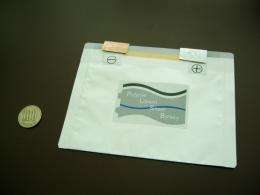Image: Tech-on
(PhysOrg.com) -- A group of scientists in Japan have invented a lithium polymer battery that can be manufactured using only printing technologies.
The project is being carried out by the Advanced Materials Innovation Center (AMIC), which belongs to an Incorporated Foundation called the Mie Industry and Enterprise Support Center (MIESC).
The lithium-polymer battery developed by the group is flexible and designed for flexible solar batteries, flexible displays, or attachment to curved surfaces. It is manufactured using printing technology, which means it can be thinner (around 500 μm) but have an increased surface area than other batteries. It can be produced cheaply, is rechargeable, and can also be laminated.
During the development process the group produced two types of prototype, with output voltages of 2 V and 4 V at ambient temperature. The battery is being developed as part of a three-year research project scheduled to end in March 2011. The group is continuing work on improving the manufacturing technologies to make them suitable for commercial production. The researchers are also working on identifying further applications for the battery.
Lithium-polymer batteries evolved in the mid 1990s from lithium-ion batteries, which have a lithium electrolyte held within an organic solvent. In the polymer batteries the electrolyte is contained within a polymer substrate such as polyethylene oxide. The polymer batteries cost less to produce and resist damage better than the lithium-ion batteries.
The Japanese battery is not the first manufactured using printing technology. In February last year a flexible battery developed in Germany by the Fraunhofer Research Institution for Electronic Nano Systems and made using printing technology was exhibited at the International Nanotechnology Exhibition and Conference, but this battery was a manganese and zinc type.
The Advanced Materials Innovation Center exists to bring together academics and researchers from the private sector together to encourage innovation. The lithium-polymer battery project is funded by Japan's Ministry of Education and Science Industry-Academia-government Cooperation Project. Participants in the project include scientists from Kureha Elastomer Co. Ltd., Toppan Printing Co. Ltd., Mie University, and Suzuka National College of Technology, among others.
© 2010 PhysOrg.com
via Tech-On



















